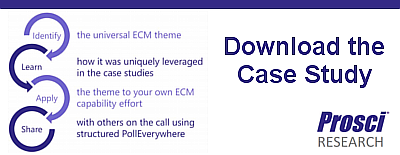Developing organisational change as a core competency is a journey that without direction could end up anywhere. Without a pre-determined destination linked to specific business performance results, properly resourced and funded, success becomes almost indiscernible. Establishing a unified direction of change and managing the journey to its achievements is a process that requires action, not just buy-in or engagement, from all organisational levels. No matter where the motion for change has arisen, the role played by executive and senior leaders consistently remains the #1 reason why some business change projects succeed, while the majority fail. According to Prosci’s 2016 Best Practices research findings from 1200 global organisations an extremely effective sponsor leading a change is 43% more likely for their project to meet its business objectives than a very ineffective sponsor.
The necessity of effective leadership during times of change
The validity of a change and the need for it as it is seen by the workforce is communicated and re-enforced through the leadership ability of the senior levels. It is the role of a leader to listen, empower, develop and celebrate the progress of the employees as they work towards change. Each of these qualities are essential characteristics of effective leadership and necessary during times of change.
Effective senior leadership creates a direct and first hand communication structure which filters from the top down. Reinforced messages regarding employee progress from every management and leadership level drives inclusion and fosters employee commitment to change, reducing overall resistance as the changes are implemented.
Leadership skills are essential at every level of the organisation in order to effectively drive a singular direction of organisational change. However, in order to ensure that the direction of change is moving consistently towards an ultimate goal, there must be a display of effective change sponsorship from senior leaders. Executive and senior management levels must actively assume a role which highlight their sponsorship of the change being undertaken by the organisation as a whole. Executive leaders must make time to become the face and voice of the change and role-model the required behaviour changes if managers and staff are to follow their example, as well as their directives. In fact according the Prosci’s 2016 Best Practices report if as an Executive we provide more than adequate access to our change management support team we are 26% more likely for our projects to meet their business goals, than if we don’t.. As an Executive having the right answer is no longer enough to ensure managers and employees commit to action.
Lack of senior sponsorship as the biggest obstacle to delivering successful change
When there is a lack of effective change sponsorship from senior leaders it has been shown that the levels of resistance towards the change increase and the progress toward realising the organisations desired results is slowed. Without this demonstrated change in ways of working from the executive level, it becomes difficult to cultivate the required levels of energy, enthusiasm and engagement for the change throughout the rest of the organisation.
So what are the 3 key roles for executives when sponsoring a change?
- Active and visible participation throughout the change lifecycle.
Executives are comfortable sponsoring a project. It involves familiar tasks – assigning and approving the budget, agreeing the scope, appointing the project team etc. Executives often find sponsoring a change more uncomfortable as it means constant, ideally weekly, communication with impacted managers and staff about the reasons why this change is vital for the organisation’s future success. Often while this communication work may be undertaken through different channels – town hall meetings, videos, newsletters etc – for it to be well understood the same messages and mantras about the business reasons for this specific change must be repeated over and over by that Executive, throughout the whole lifecycle of the change. Consequently while Executives find they can sponsor many projects simultaneously, they can usually only sponsor a much smaller number of changes if they are to deliver a measurable improvement in business performance.
- Build a coalition with peers and Managers.
A simple truth of all change is that it will be resisted to varying degrees by some of our peers and Managers we lead. As an Executive sponsoring change it is our role to create the environment for these peers and Managers to feel comfortable in surfacing their resistance to us, face to face, without fear of recrimination. Working with our change team for the project we can then determine the right way of mitigating this natural resistance, one peer/Manager at a time, to a level where they make a choice to positively participate in our change rather than to resist it. In that way we build a coalition for our change, a positive snowball of accountability for our change’s success.
- Communicate directly.
Our preferred method of communication is face to face. As an Executive charged with effective sponsorship of a change we must therefore commit whatever time is required for multiple face to face communication interventions with Managers and staff directly impacted by the change we are leading. Our explanation of why change is required needs to be consistent, concise and clear but also needs to be customised for the different groups being directly impacted. The good news is that we are not alone though! Our change management practitioners within the organisation can help prepare the right messages, they can rehearse us, they can schedule our time to deliver the volume and quality of face to face interventions required. If only we let them, change management practitioners can also keep us Executive Sponsors informed on progress with the adoption of our change by impacted employees and with the success of our coalition building efforts.
In order to effectively assume a change sponsorship role, the ABC of great sponsorship is vital, as managing the attitudes and engagement levels of the employee workforce to drive success requires higher levels of involvement; achieved through the qualities and characteristics already highlighted as integral. To deliver the nuances of change Senior Executive leaders must resource and fund a network of dedicated change management support and training delivered through the management chain. Also, from Prosci’s 2016 Best Practices report with 58% of Sponsors having none to only some understanding of their change role Senior Executives must also commit to receive training and coaching in better change leadership themselves.
Driving change throughout an organisation requires effective leadership skills from all management levels, most especially from the top, to ensure that all directly impacted employees choose to opt-in to the required new ways of working.
Case Study Lessons in ECM
Get your free copy of Prosci's Case Study Lessons in ECM to learn how it was uniquely leveraged by leaders.




